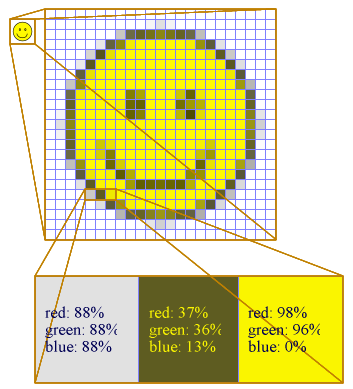Raster graphics
|
|

A raster graphics image, digital image, or bitmap, is a data file or structure representing a generally rectangular grid of pixels, or points of color, on a computer monitor, paper, or other display device. The color of each pixel is individually defined; images in the RGB color space, for instance, often consist of colored pixels defined by three bytes—one byte each for red, green and blue. Less colorful images require less information per pixel; an image with only black and white pixels requires only a single bit for each pixel. Raster graphics are distinguished from vector graphics in that vector graphics represent an image through the use of geometric objects such as curves and polygons.
A bitmap corresponds bit for bit with an image displayed on a screen, probably in the same format as it would be stored in the display's video memory or maybe as a device independent bitmap. A bitmap is characterized by the width and height of the image in pixels and the number of bits per pixel, which determines the number of colors it can represent.
A colored raster image (or pixmap) will usually have pixels with between one and eight bits for each of the red, green, and blue components, though other color encodings are also used, such as four- or eight-bit indexed representations that use vector quantization on the (R, G, B) vectors. The green component sometimes has more bits than the other two to cater for the human eye's greater discrimination in this component.
The quality of a raster image is determined by the total number of pixels (resolution), and the amount of information in each pixel (often called color depth). For example, an image that stores 24 bits of color information per pixel (the standard for all displays since around 1995) can represent smoother degrees of shading than one that only stores 16 bits per pixel, but not as smooth as one that stores 48 bits (technically; this would not be decipherable by the human eye). Likewise, an image sampled at 640 x 480 pixels (therefore containing 307,200 pixels) will look rough and blocky compared to one sampled at 1280 x 1024 (1,310,720 pixels). Because it takes a large amount of data to store a high-quality image, data compression techniques are often used to reduce this size for images stored on disk. Some techniques sacrifice information, and therefore image quality, in order to achieve a smaller file size. Compression techniques that lose information are referred to as "lossy" compression.
Raster graphics cannot be scaled to a higher resolution without loss of apparent quality. This is in contrast to vector graphics, which easily scale to the quality of the device on which they are rendered. Raster graphics are more practical than vector graphics for photographs and photo-realistic images, while vector graphics are often more practical for typesetting or graphic design. Early 21st century computer monitors typically display about 72 to 130 pixels per inch (PPI), and some modern consumer printers can resolve 2400 dots per inch (DPI) or more; determining the most appropriate image resolution for a given printer resolution can be difficult, since printed output may have a greater level of detail than can be discerned on a monitor.
Raster example
To illustrate the matter further - here's the letter "J":
J
Look closely at it... Take a magnifying glass to it if you like. You see a "J", the computer sees something more like this, where '.' represents a zero and 'X' represents a one:
....X ....X ....X ....X ....X ....X ....X X...X X...X .XXX.
Where you see a zero, the computer instructs its video hardware to paint the current background color. A one calls for the current foreground color. Yes, it is actually a bit more complicated, but it all basically boils down to one bit or the other making a distinction between the colors of adjacent pixels, which together form an image. This is the basic principle behind drawing on a computer.
In 3D computer graphics, the concept of a flat raster of pixels is sometimes extended to a three dimensional volume of voxels. In this case, there is a regular grid in three dimensional space with a sample containing color information at each point in the grid. Although voxels are powerful abstractions for dealing with complex 3D shapes, they do have large memory requirements for storing a sizable array. Consequently, vector graphics are used more frequently than voxels for producing 3D imagery.
Raster graphics was first patented by Texas Instruments in the 1970s, and is now ubiquitous.
See also
- Vector graphics
- Image resolution
- bit blit
- RasterOp
- Bitmap font
- Bitmap graphics editor
- Typography
- map#Electronic maps
For practical information on using raster graphics:
References
- This article was originally based on material from the Free On-line Dictionary of Computing, which is licensed under the GFDL.
de:Rastergrafik fi:Bittikarttagrafiikka fr:Bitmap it:Grafica bitmap ja:ビットマップ画像 nl:Rasterafbeelding pl:Grafika rastrowa pt:Raster sv:Rastergrafik zh:位图
